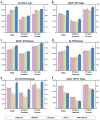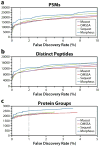A proteomics search algorithm specifically designed for high-resolution tandem mass spectra
- PMID: 23323968
- PMCID: PMC3586292
- DOI: 10.1021/pr301024c
A proteomics search algorithm specifically designed for high-resolution tandem mass spectra
Abstract
The acquisition of high-resolution tandem mass spectra (MS/MS) is becoming more prevalent in proteomics, but most researchers employ peptide identification algorithms that were designed prior to this development. Here, we demonstrate new software, Morpheus, designed specifically for high-mass accuracy data, based on a simple score that is little more than the number of matching products. For a diverse collection of data sets from a variety of organisms (E. coli, yeast, human) acquired on a variety of instruments (quadrupole-time-of-flight, ion trap-orbitrap, and quadrupole-orbitrap) in different laboratories, Morpheus gives more spectrum, peptide, and protein identifications at a 1% false discovery rate (FDR) than Mascot, Open Mass Spectrometry Search Algorithm (OMSSA), and Sequest. Additionally, Morpheus is 1.5 to 4.6 times faster, depending on the data set, than the next fastest algorithm, OMSSA. Morpheus was developed in C# .NET and is available free and open source under a permissive license.
Figures






Similar articles
-
Optimization of Search Engines and Postprocessing Approaches to Maximize Peptide and Protein Identification for High-Resolution Mass Data.J Proteome Res. 2015 Nov 6;14(11):4662-73. doi: 10.1021/acs.jproteome.5b00536. Epub 2015 Sep 30. J Proteome Res. 2015. PMID: 26390080 Free PMC article.
-
Enhanced peptide identification by electron transfer dissociation using an improved Mascot Percolator.Mol Cell Proteomics. 2012 Aug;11(8):478-91. doi: 10.1074/mcp.O111.014522. Epub 2012 Apr 6. Mol Cell Proteomics. 2012. PMID: 22493177 Free PMC article.
-
MassWiz: a novel scoring algorithm with target-decoy based analysis pipeline for tandem mass spectrometry.J Proteome Res. 2011 May 6;10(5):2154-60. doi: 10.1021/pr200031z. Epub 2011 Apr 5. J Proteome Res. 2011. PMID: 21417338
-
HI-bone: a scoring system for identifying phenylisothiocyanate-derivatized peptides based on precursor mass and high intensity fragment ions.Anal Chem. 2013 Apr 2;85(7):3515-20. doi: 10.1021/ac303239g. Epub 2013 Mar 20. Anal Chem. 2013. PMID: 23448308
-
The spectral networks paradigm in high throughput mass spectrometry.Mol Biosyst. 2012 Oct;8(10):2535-44. doi: 10.1039/c2mb25085c. Mol Biosyst. 2012. PMID: 22610447 Free PMC article. Review.
Cited by
-
The SEQUEST family tree.J Am Soc Mass Spectrom. 2015 Nov;26(11):1814-9. doi: 10.1007/s13361-015-1201-3. Epub 2015 Jun 30. J Am Soc Mass Spectrom. 2015. PMID: 26122518 Free PMC article.
-
Proteomics of neurodegenerative diseases: analysis of human post-mortem brain.J Neurochem. 2019 Nov;151(4):435-445. doi: 10.1111/jnc.14603. Epub 2018 Nov 22. J Neurochem. 2019. PMID: 30289976 Free PMC article. Review.
-
Advances in neuroproteomics for neurotrauma: unraveling insights for personalized medicine and future prospects.Front Neurol. 2023 Nov 22;14:1288740. doi: 10.3389/fneur.2023.1288740. eCollection 2023. Front Neurol. 2023. PMID: 38073638 Free PMC article. Review.
-
Effective assembly of fimbriae in Escherichia coli depends on the translocation assembly module nanomachine.Nat Microbiol. 2016 May 16;1(7):16064. doi: 10.1038/nmicrobiol.2016.64. Nat Microbiol. 2016. PMID: 27572967
-
Aedes aegypti Aag-2 Cell Proteome Modulation in Response to Chikungunya Virus Infection.Front Cell Infect Microbiol. 2022 Jun 15;12:920425. doi: 10.3389/fcimb.2022.920425. eCollection 2022. Front Cell Infect Microbiol. 2022. PMID: 35782121 Free PMC article.
References
-
- Morris HR, Paxton T, Dell A, Langhorne J, Berg M, Bordoli RS, Hoyes J, Bateman RH. High sensitivity collisionally-activated decomposition tandem mass spectrometry on a novel quadrupole/orthogonal-acceleration time-of-flight mass spectrometer. Rapid Commun Mass Sp. 1996;10:889–896. - PubMed
-
- Kristensen DB, Imamura K, Miyamoto Y, Yoshizato K. Mass spectrometric approaches for the characterization of proteins on a hybrid quadrupole time-of-flight (Q-TOF) mass spectrometer. Electrophoresis. 2000;21:430–439. - PubMed
-
- Loboda AV, Krutchinsky AN, Bromirski M, Ens W, Standing KG. A tandem quadrupole/time-of-flight mass spectrometer with a matrix-assisted laser desorption/ionization source: design and performance. Rapid Commun Mass Sp. 2000;14:1047–1057. - PubMed
-
- Syka JEP, Marto JA, Bai DL, Horning S, Senko MW, Schwartz JC, Ueberheide B, Garcia B, Busby S, Muratore T, Shabanowitz J, Hunt DF. Novel linear quadrupole ion trap/FT mass spectrometer: Performance characterization and use in the comparative analysis of histone H3 post-translational modifications. J Proteome Res. 2004;3:621–626. - PubMed
-
- Makarov A, Denisov E, Kholomeev A, Baischun W, Lange O, Strupat K, Horning S. Performance evaluation of a hybrid linear ion trap/orbitrap mass spectrometer. Anal Chem. 2006;78:2113–2120. - PubMed
Publication types
MeSH terms
Substances
Grants and funding
LinkOut - more resources
Full Text Sources
Other Literature Sources
Molecular Biology Databases

